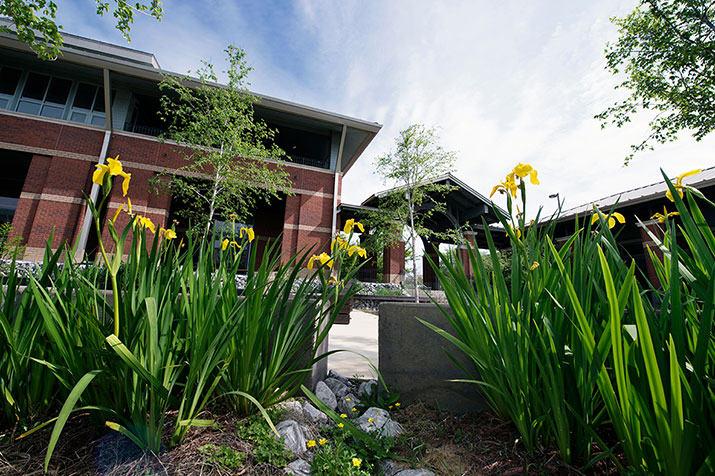Facilities

The Landscape Architecture Facility features regenerative technologies which are designed to use less energy and produce better air quality. That's because the facility that opened in December 2002 was planned from the ground up—literally—with a very focused eye toward conservation.
Among the single-story facility’s many energy-savings features:
- Wide overhangs to block summer sun and allow winter sun for heating;
- Tall, clerestory and dormer windows to allow natural lighting; and
- Highly reflective roofing material.
- In cooperation with the Tennessee Valley Authority, a bank of photo-voltaic solar panels that provide enough power to run the facility
Human Life Support Systems
This facility was designed to meet the life support needs for its 250 student and staff users. Human life support systems require the provision of food, water, shelter, energy, waste processing, and landscape management in order to sustain life. Life support systems planned for this facility include an energy efficient shelter for a Deep South location, water harvesting for irrigation, and for drinking, provisions to treat sewage using biological systems, harvesting of wild energy and thrifty use of energy, food production, and management of the landscape consistent with a site's natural plant communities and cycles.
Shelter Design Envisioned
Design shelters that are responsive to the region's climate, and reflect the local culture and vernacular character of an area. When developing the program for the facility, it was determined a series of shelters connected by porches or covered walkways would provide the right character and scale that would fit the narrow, linear site, and that would suit the Deep South users. An arbor or pergola that would provide shade and protection from hot, summer sun was also envisioned. Shelters were expected to reflect the character of indigenous structures in the region which are often brick, have lots of tall windows for natural day lighting, and low pitched roofs with broad overhangs for sun control. Tree plantings for sun control was also anticipated. We envisioned a series of shelters that were interconnected and that stepped down the hillside. The size of multiple shelters also fit the scale of the site, and allowed for more natural day lighting. Our program asked for shelters that kept the sun off building sides in the summer.
Materials were Selected for Low Embedded Energy
Select materials that do not require excessive energy to produce and transport to get to the point of use. Because of this consideration, most materials used on the project were available close-by, or within the region. Brick and concrete block are available within 50-100 miles (80-160 km). Steel is available within a 150 mile (241 km) range, as is window glass. Concrete is produced within 60 miles (97 km) of the site. Polystyrene used for insulation in the walls and roof, and gypsum board are produced within 350 miles (563 km).
Materials Selected had no Volatile Organic Compounds
Select building materials and interior furnishings that do not outgas chemicals thereby contaminating indoor air. Whether or not materials emitted volatile organic compounds was considered, and almost exclusively, materials were selected that had no VOC's. Sheet flooring from Holland was selected to cover improperly cut concrete scoring in the reception area of the Office/Gallery facility. It was composed of all natural materials, and the glue for attaching it to the concrete was of natural materials as well. Unlike most sheet flooring, neither product emits VOC's. Outgasing of VOC's within indoor spaces can be very harmful to people causing upper respiratory and neurological disorders.
Natural Day Lighting and the Use of Innovative Whiteboards from Smart Technologies
The Landscape Architecture and Landscape Contracting Facility at Mississippi State University has been designed to use at least 50% less power than traditional buildings on campus. This has been accomplished through siting the long side of the shelters to face south, inclusion of a thick layer of polystyrene in the roofs that does not allow heat to enter through the roof, construction of walls that do not allow heat to enter the building, and through the use of air lock systems to reduce the addition and loss of heat. Through reducing the use of fossil fuel, the production of CO2 from the burning of the fuel is also being reduced. Additionally, the facility has been designed to allow natural day lighting to flood all of the interior spaces to the point that electrical lighting during the day is unnecessary. Interior light levels in the center of the design studios is at 30 footcandles on a cloudy day during the winter! This is the amount of light needed in traditional office spaces where computers are in use. The natural light is also good for production and human attitudes. Interestingly though, when it comes to being able to show slides and projection of images from projectors, there is too much light and new technology is needed to convey graphic images in natural day lighted buildings of the future.
Interactive whiteboards from Smart Technologies, Inc. are being planned for use in the three design studios and one classroom demonstrating how energy conservation and the use of natural day lighting can work effectively together while still allowing the presentation of graphic images to class room participants.
This condition at the sustainable landscape architecture and landscape contracting facility at Mississippi State University is innovative and on the leading edge of energy consciousness combined with meeting the needs for effective classroom instruction.
Quick Links
- Our Majors
- Apply Online
- Schedule a Visit
- Locate Us
- Tuition Costs
- Make a Gift
- Tour our Facilities
- Alumni and Friends
- Media
Events
70th Edward C. Martin, Jr. Landscape Symposium
Wednesday, October 15, 2025
